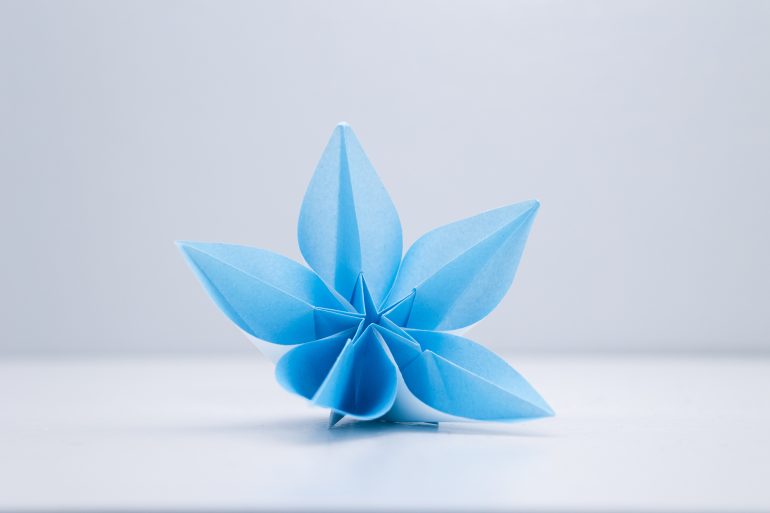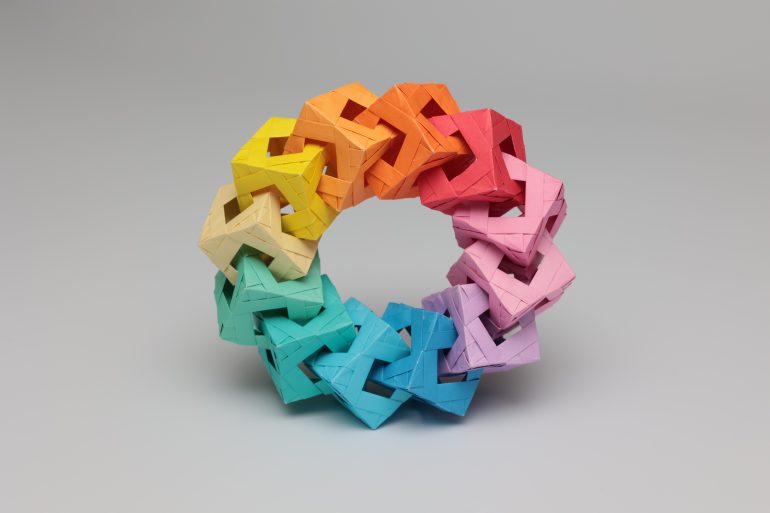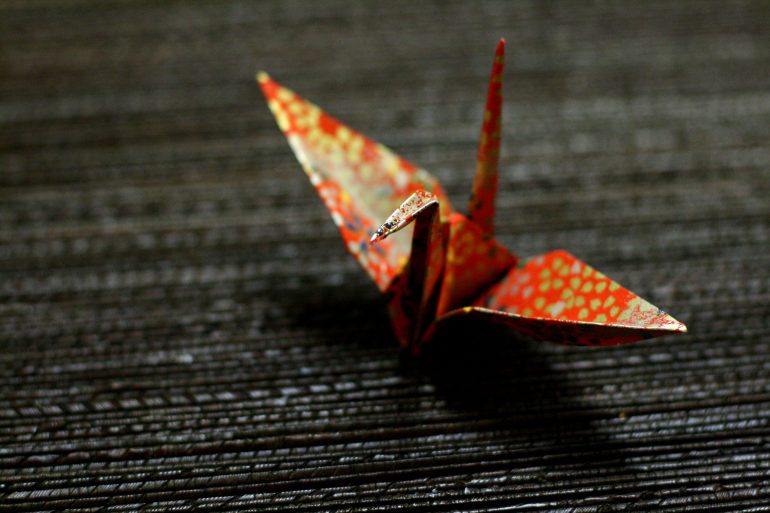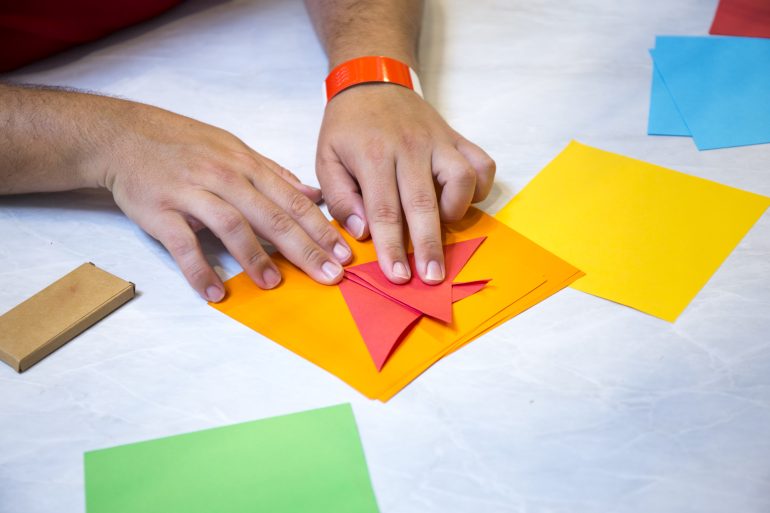At its essence, origami transforms a simple, two-dimensional sheet of paper into a beautifully crafted three-dimensional sculpture, purely through folding, without the aid of cuts or glue. But the origami meaning – ori is the Japanese word for ‘folding’ and gami translates as ‘paper’ – is more than just pieces of intricately folded paper.
This fascinating craft has roots dating back to the sixth century, when paper came to Japan. From then, origami has blossomed into a cultural phenomenon which has come to symbolise elegance, precision, and creativity, as well as in recent times, cutting-edge science.
But what is paper origami? Here, we’ll tell the story of this incredible artform and we’ll find out what paper to use for origami.
What is Origami?

An Origami blue blooming flower folded from paper. (Credit: OsakaWayne Studios via Getty Images)
Origami is the traditional Japanese art of paper folding, where a flat sheet of paper is transformed into a sculptural form, often resembling animals, plants, and other objects, through intricate folds and creases without the use of cuts or glue.
Beyond its aesthetic appeal, origami has expanded into various fields like mathematics, engineering, and space technology due to the geometric principles inherent in paper folding. Today, this ancient craft not only symbolises elegance and creativity but also serves as an intersection between art and science, driving innovations and inspiring solutions in contemporary challenges.
A Short History of Origami

19th century Illustration of pine branches and paper cranes (Photo by Heritage Art/Heritage Images via Getty Images)
What is Japanese origami? Interestingly, the roots of paper folding come from China, however the earliest instances of origami itself are from Japan, which were ritualistic and religious in nature. For example, paper butterflies were folded to adorn sake bottles at Shinto weddings, and as these paper decorations and stylised gift wrappings became more established, ceremonial origami began to slowly evolve.
During the Heian period (794—1185 AD), paper folding was mostly for ceremonial purposes. Noshi, a kind of geometric origami fold, was often attached to gifts as tokens of good luck and to convey special sentiments at celebrations such as weddings and feasts.
The answer to the question ‘what is paper origami’ began to take shape during the Edo period, which lasted from 1603 until 1868. During this time, origami began to evolve as a recreational and artistic endeavour. This was due in part to the increased availability and affordability of paper, which made it more accessible to the general public. As paper became more common, people started folding it for entertainment and artistic expression.
It was during this time that the first origami books are believed to have been written. In 1747, a book titled Ranma zushiki contained several origami designs, including the famous crane which remains one of the most popular designs to this day. Fifty years later, the oldest extant technical book on origami was published, called Hiden senbazuru orikata. It contained 49 origami designs with instructions from a Buddhist monk called Gidō.
These creations were far more complex than the designs in Ranma zushiki which suggests that the late eighteenth century was a golden age of origami culture.
Modern Origami

This modern, modular origami dodecahedron was created using tant origami paper. (Credit: Indie Studios LLC via Getty Images)
Over the last fourteen centuries, the answer to the question ‘what is Japanese origami’ has changed quite dramatically. By the late nineteenth and twentieth centuries, origami had grown further, with written instructions for paper folding appearing in publications.
It was during the twentieth century that figures like Akira Yoshizawa and American physicist Robert J. Lang transformed and modernised origami into the high art form we recognise today. Yoshizawa, in particular, developed a system of symbols and diagrams to describe origami folds, which has become widely accepted and used internationally.
Beyond Art

Rainbow geometric origami paper. (Credit: OsakaWayne Studios via Getty Images)
In the modern era, what is Japanese origami has become a question that has extended its influence far beyond art and recreation, making notable strides in fields such as mathematics, engineering, and space exploration.
Mathematicians are drawn to origami because of the geometric principles inherent in paper folding, leading to the formulation of principles describing how any object can be folded. This framework aids designers in understanding and predicting the folding patterns of various materials, proving crucial in areas like medical implants and electronics.
In addition, origami’s potential in engineering and space technology has been revolutionary. The inherent compactness of folded structures and their ability to expand has led scientists to design deployable structures for space. An example of this can be seen in some satellite solar panels and space telescopes, which are transported compactly and then deployed once in space. The intricate principles of origami, stemming from humble paper and folds, are driving innovations in fields that impact the very frontiers of human exploration and technology.
All in a Name

An origami paper crane made with patterned red chiyogami. (Credit: Takami Shimura via Getty Images)
For well over a thousand years, asking the question ‘what is origami’ would have resulted in puzzled looks. Historically, the art was referred to using various terms, such as orikata, orisue, or orimono. The term ‘origami’ itself started to be used as late as the nineteenth century. Some sources suggest that the term became popular during the Meiji Era (1868-1912) and subsequently established itself as the common reference for the art of paper folding.
Origami has also been adopted and adapted by various cultures around the world, and it sometimes takes on different names in different languages. For example in Spanish, it is known as papiroflexia, derived from papiro (paper) and flexia (flex). Pajarita is another term used, which means ‘little bird,’ and it’s also the name of a traditional folded paper figure.
Other words for origami all translate as ‘paper folding’ or ‘folded paper’ and include zhézhǐ (Chinese), jeopji (Korean), papierfalten (German), pliage de papier (French) and carta piegata (Italian).
While these terms might be used in the native languages of the respective countries, the word origami is internationally recognised due to the global spread of the Japanese art form, and is often used alongside or even in place of native terms in many countries.
Picking the Perfect Paper

Top view of different types of paper used for Origami. (Credit: PhanuwatNandee via Getty Images)
Choosing what paper to use for origami is very important, as different models may require different types of paper depending on their complexity and the desired final appearance.
When choosing paper for origami, consider the requirements of the model you’re folding. Complex models might need thinner, stronger paper, while simpler models can be folded from a variety of paper types. Over time, many origami artists develop personal preferences and might even venture into making their own paper to achieve specific textures or qualities.
Kami
This is the most common and recognisable type of origami paper. It’s usually white on one side and coloured or patterned on the other. Kami is thin and easy to fold, making it perfect for a wide range of origami models. When you start searching ‘what is origami’, this is one of the most popular paper choices for beginners.
Washi
This is a traditional Japanese paper made from the fibres of the gampi tree, the mitsumata shrub, or the paper mulberry. It’s thicker than kami and has a distinct texture. Due to its strength and flexibility, it’s suitable for complex models.
Tant
This is a high-quality paper that comes in a wide range of colours. It’s slightly thicker than kami and has a texture similar to that of watercolour paper.
Foil
A thin layer of foil applied to a sheet of thin paper. It can be moulded into a shape and will hold that shape more rigidly than kami.
Double-Sided
As the name suggests, this paper has different colours or patterns on each side. When you’re deciding what paper to use for origami, this is particularly useful for models where both sides of the paper will be visible in the finished product.
Lokta and Unryu
Lokta is made from the Nepalese Lokya bush and Unryu translates as ‘cloud dragon.’ These are handmade papers with visible swirling fibres, giving them a textured, artistic and ethereal appearance. They can be slightly more challenging to fold due to their thickness and texture, but the finished models can look incredible.
Momi
This is a crinkled, soft paper often used for more advanced folds because it can be moulded easily.
Glassline
A smooth, translucent paper that’s resistant to grease and air. It’s occasionally used for origami, especially for projects where translucency can enhance the design.
Sekishu Washi
One of the oldest types of Japanese paper known for its strength and smooth texture. It’s possible the original origami artists in the seventh century may have used Sekishu Washi.
The Last Fold

The final fold of an origami creation. (Credit: GEOLEE via Getty Images)
What is paper origami? After taking a trip through the intricate folds and historical layers of origami, it becomes evident that this ancient art form is much more than merely folding paper.
It’s a harmonious blend of tradition, creativity, and technical skill, passed down through almost 1,400 years of Japan’s rich and vibrant history. From its ceremonial beginnings in Japan’s Shinto shrines to its modern interpretations worldwide, origami beautifully encapsulates the essence of human expression, transforming a simple sheet of paper into art.
Whether you’re a seasoned artist or a curious beginner, looking for answers to the question ‘what is origami’ invites you into an intriguing world of infinite possibilities, one intricate fold at a time.












